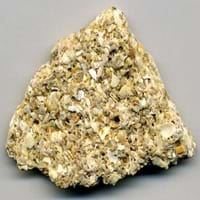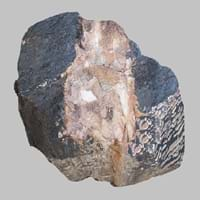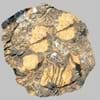Coquina and Claystone
Definition
Definition
Coquina is a sedimentary rock that is composed either wholly or almost entirely of the transported, abraded, and mechanically-sorted fragments of the shells of molluscs, trilobites, brachiopods, or other invertebrates
Claystone is a fine-grained, dark gray to pink sedimentary rock which mainly consists of compacted and hardened clay
History
Origin
European Foreland Basins
Unknown
Discoverer
Unknown
Unknown
Etymology
From Concha (Latin)+ Coquina(Spanish) +conch(English)= Couquina (mid 19th century)
From English clay and stone as the rock contains more amount of clay
Class
Sedimentary Rocks
Sedimentary Rocks
Sub-Class
Durable Rock, Soft Rock
Durable Rock, Medium Hardness Rock
Family
Group
Not Applicable
Not Applicable
Other Categories
Coarse Grained Rock, Opaque Rock
Fine Grained Rock, Opaque Rock
Texture
Texture
Clastic
Clastic
Color
Beige, Buff, Orange
Black, Blue, Brown, Green, Grey, Orange, Red, White, Yellow
Maintenance
More
More
Durability
Non-Durable
Durable
Water Resistant
No
Yes
Scratch Resistant
No
Yes
Stain Resistant
No
No
Wind Resistant
No
No
Acid Resistant
No
No
Appearance
Layered, Banded, Veined and Shiny
Rough and Dull
Uses
Architecture
Interior Uses
Decorative Aggregates, Homes, Hotels, Interior Decoration
Decorative Aggregates, Entryways, Floor Tiles, Homes, Interior Decoration
Exterior Uses
Garden Decoration, Office Buildings
As Facing Stone, Roof Tiles
Other Architectural Uses
Curbing
Curbing
Industry
Construction Industry
Building houses or walls, Construction Aggregate
As a Sintering Agent in Steel Industry to process Iron Ore, Cement Manufacture, Construction Aggregate, for Road Aggregate, Making natural cement, Raw material for the manufacture of mortar
Medical Industry
Not Yet Used
Not Yet Used
Antiquity Uses
Artifacts, Monuments, Sculpture, Small Figurines
Artifacts, Sculpture, Small Figurines
Other Uses
Commercial Uses
Creating Artwork
Pottery
Types
Types
Not Available
Not Available
Features
Available in Lots of Colors and Patterns, Is one of the oldest rock
Available in Lots of Colors and Patterns, Smooth to touch, Very fine grained rock
Archaeological Significance
Monuments
Used
Not Yet Used
Famous Monuments
Data Not Available
Not Applicable
Sculpture
Used
Used
Famous Sculptures
Data Not Available
Data Not Available
Pictographs
Used
Used
Petroglyphs
Used
Used
Figurines
Used
Used
Fossils
Present
Present
Formation
Formation
Coquina is a sedimentary rock which is formed when billions of small clam-like seashell, called Coquina, or cockleshell are die and hence are deposited, buried and turns into a rock when pressure is applied.
Claystone is generally quite soft, but can be hard and brittle. It forms due to weathering of mudstone.
Composition
Mineral Content
Apatite, Augite, Bronzite, Calcite, Chert, Chlorite, Clay Minerals, Epidote, Feldspar, Garnet, Micas, Muscovite or Illite
Biotite, Chlorite, Feldspar, Micas, Muscovite or Illite, Plagioclase, Pyrite, Quartz
Compound Content
CaO, Carbon Dioxide, Iron(III) Oxide, MgO
Aluminium Oxide, Ca, NaCl, CaO, Iron(III) Oxide, MgO, Silicon Dioxide
Transformation
Metamorphism
No
No
Types of Metamorphism
Not Applicable
Not Applicable
Weathering
Yes
Yes
Types of Weathering
Biological Weathering, Chemical Weathering, Mechanical Weathering
Biological Weathering, Chemical Weathering, Mechanical Weathering
Erosion
Yes
Yes
Types of Erosion
Coastal Erosion, Sea Erosion, Water Erosion, Wind Erosion
Coastal Erosion, Water Erosion
Properties
Physical Properties
Hardness
1-2
3.5-4
Grain Size
Coarse Grained
Fine Grained
Fracture
Irregular
Not Available
Streak
White
White
Porosity
Highly Porous
Very Less Porous
Luster
Dull to Vitreous to Submetallic
Dull
Cleavage
Not Available
Perfect
Toughness
Not Available
2.6
Specific Gravity
1.10-2.24
0
Transparency
Opaque
Opaque
Density
2.8-2.9 g/cm3
2-2.9 g/cm3
Thermal Properties
Specific Heat Capacity
Not Available
0.92 kJ/Kg K
10
Resistance
Heat Resistant, Impact Resistant, Pressure Resistant, Wear Resistant
Heat Resistant, Impact Resistant
Reserves
Deposits in Eastern Continents
Asia
Not Yet Found
Bangladesh, China, India, Russia
Africa
Not Yet Found
Ethiopia, Kenya, Morocco, South Africa, Tanzania
Europe
United Kingdom
Austria, France, Germany, Greece, Italy, Romania, Scotland, Spain, Switzerland
Others
Not Yet Found
Not Yet Found
Deposits in Western Continents
North America
USA
Canada, Panama, USA
South America
Not Yet Found
Bolivia, Chile, Colombia, Ecuador, Peru, Venezuela
Deposits in Oceania Continent
Australia
Not Yet Found
New South Wales, New Zealand, Queensland, Victoria, Western Australia
All about Coquina and Claystone Properties
Know all about Coquina and Claystone properties here. All properties of rocks are important as they define the type of rock and its application. Coquina and Claystone belong to Sedimentary Rocks.Texture of Coquina is Clastic whereas that of Claystone is Clastic. Coquina appears Layered, Banded, Veined and Shiny and Claystone appears Rough and Dull. The luster of Coquina is dull to vitreous to submetallic while that of Claystone is dull. Coquina is available in beige, buff, orange colors whereas Claystone is available in black, blue, brown, green, grey, orange, red, white, yellow colors. The commercial uses of Coquina are creating artwork and that of Claystone are pottery.
|
||
|
||
|










